John F. Kennedy Library & Museum
Thursday, October 26, 2006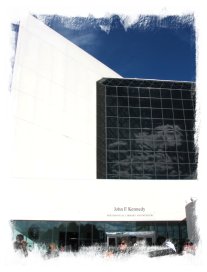
After such a great experience at the FDR Library in New York, we were looking forward to visiting the JFK library on the University of Massachusetts campus, across the bay from Boston. Housed in a striking building designed by I.M. Pei (the architect of the art museum at the Louvre, and the John Hancock building here in Boston), the library sits with a dramatic view of the bay and the Boston skyline.
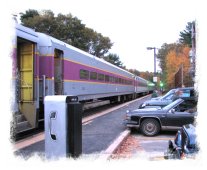
After having dealt with Boston traffic and roads on Sunday (the day before), we decided to give the MBTA (Massachusetts Bay Transit Authority) a try. A commuter rail lines runs a couple of miles from the campground and from there it was a couple of transfers on the subway system and a short bus ride to the library. It turned out to be a pleasant and relatively scenic ride in, and costwise was comparable to gas and intown parking.
I’ve driven in almost every major city in the U.S., and Boston is the only one that has intimidated me. Traffic signals are nearly meaningless, pedestrians are everywhere, cars are routinely double or triple parked on both sides of the roads, and it’s nearly impossible to find your way around downtown. Part of the reason is the never ending ‘Big Dig’, where I-93 is being tunneled under downtown Boston. There are a lot less Dig oriented detours now than the last time I was in Boston, but there are still enough to make things ‘interesting’. The main problem, however, with Boston driving is all the one way streets. Unlike many towns, I can’t find any rhyme or reason to what streets go in one direction vs. the other. Despite some real time spent studying a map, I have yet to discover a way to cross downtown without 5 or 6 zig zags. After driving a few blocks, you invariably come to a Do Not Enter sign, with the road straight in front of you now a one way in the opposite direction, forcing you to turn. Yikes!
For example, Boston Commons, a roughly rectangular park in the middle of downtown, is bisected by a road down the middle. In order to circle the park, you have to execute a figure 8 pattern because of the one ways – you just can’t drive around the edge. Argggghhh!
One of our tour guides later in the week mentioned as a joke: “never use your blinkers, it’s seen as a sign of weakness”.
Finally, many of the parking garages are low. We pulled into one, marked as 6’ 5’’, which should be enough to get in with the truck. However, the bar at the ticket booth rested alarmingly low over the roofline, so we had to pull back out, another adventure in Boston driving. We finally found one after another figure 8 around Boston Commons, which took about 30 mins (in mid Sunday afternoon).
To put it mildly, driving in Boston is a nightmare, particularly in a big, long truck.
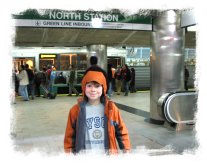
Back to the mass transit, however – it is wonderful. We’ve taken the train into town three days in a row, and combined with the subway system it's a great way to get around. The trains arrive and leave on schedule. The subway comes by about every 5 mins, so it’s not a big deal to wait for the next train. The subways are color coded, and unlike some cities (New York, for example), it’s easy to figure out what train you need to catch. Finally, we’ve yet to walk more than 3-4 blocks to catch a subway. I could easily see living in Boston without a car – it’s remarkably easy to get around, as long as you aren’t at the wheel! Ditch the car, and immerse yourself into Boston street life. There are always lots of people walking, regardless of the hour, and the city becomes a lot of fun once you eliminate the transportation hassles of driving.
So why am I spending so much time talking about the Boston transit system rather than the JFK Library? Because I found it rather disappointing. It’s not a bad museum; however, it’s not a very good one either.
If asked to write an outline of the highlights of the JFK presidency (the famous 1000 days), you might possibly list the following events:
- Bay of Pigs
- The Cuban Missile Crisis
- Civil Rights Struggle
- Space Race (Push to the Moon)
- Vietnam
- Kennedy Assassination
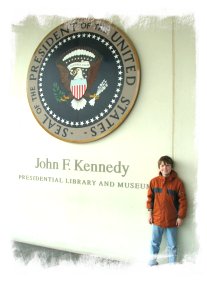
It’s a fluff piece of a museum. There is no controversy, all issues are one sided, and absolutely no depth. It felt like a museum full of barely related knick knacks. I know I’m being harsh, but there was simply no comparison to the FDR Library. In that museum, multiple points of view were presented, uncomfortable topics were addressed head on, and in depth coverage was given to a 13 year long presidency. In contrast, very little details of a 1000 day presidency is offered at JFK.
The museum seems to assume that you know all about the JFK presidency, and largely attempts to simply support and reinforce what you already know. Questions like the ones below are either ignored or barely touched on:
- Why would Kennedy have enemies who would kill him?
- Why was Robert Kennedy shot?
- How did Kennedy go from a relatively unknown congressman to the President of the United States?
- What political pressures was Kennedy under during the Civil Rights movement of the early 60’s, including the integration of Mississippi and Alabama colleges?
- What was the New Frontier?
- Why did the escalation in Vietnam occur?
- What was so controversial about the Warren Commission Report?
- What was Camelot, and in what ways did JFK and Jackie capture the nation's imagination?
You get the drift.
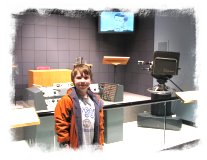
The interesting thing about Kennedy is how intertwined his administration was with the coming of age of TV. The best exhibit by far was about the Nixon-Kennedy debates. Clips from the first debate are shown on monitors, and it is quite interesting to watch Kennedy's and Nixon’s posture, attitudes and levels of confidence. For all the mythology surrounding these debates, I didn’t find the difference between the two all that dramatic, although it was surprising to see a much younger Richard Nixon than we are used to (usually remembering him from his years as president.) There was a decent exhibit showing how close the popular vote was (only 100,000 votes separating them nationwide), although Kennedy won handily in the Electoral College vote. I felt the museum missed a golden opportunity here to explain about the Electoral College, and I made it a point to try to explain the difference between the popular vote count and how we actually elect our presidents to Vance.
The Kennedy mystique is still in full force. After viewing multiple videos of Kennedy family outings: sailing, football games, picnics, etc....Vance was hooked. When we left the library, he told us emphatically "I wish our family was like the Kennedy's!" Even 40+ years later, Camelot can still reel them in....
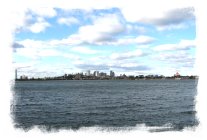
If you are looking for stroll down memory lane, where our President was an idealist whose life was inexplicably and tragically cut short, this is your place. If you are looking for somewhere to actually learn something about John F. Kennedy, try somewhere else.
The view across the bay is spectacular, though…..

Vance: JFK library is the Presidential Library for John F. Kennedy. JFK was our 35th president. Some people believe he was “The savior of the United States.” That is because he stopped the Cuban Missile Crisis. Russia was creating missile bases in Cuba. My dad says this was the closest the U.S. has come to destruction. Russia’s leader said if one Russian ship was sunk, it would lead to nuclear war. If that war broke out, both sides would have been destroyed.
As most of you know, JFK was assassinated on Nov. 22, 1963. Today, Ted Kennedy, one of John F. Kennedy’s brothers, is a senator in Massachusetts.
JOHN F. KENNEDY’S LIBRARY TAUGHT ME A LOT ABOUT JFK’S LIFE!
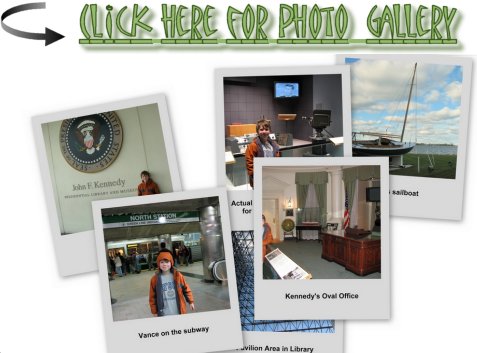







<< Home